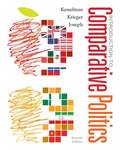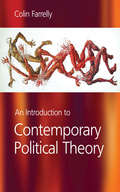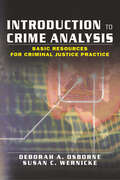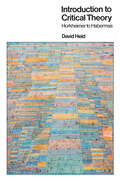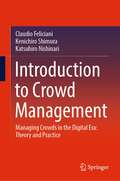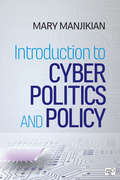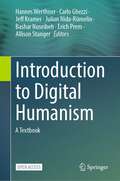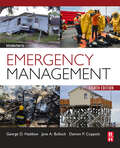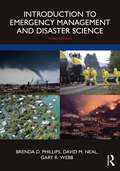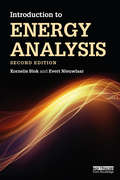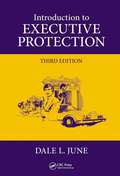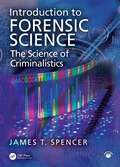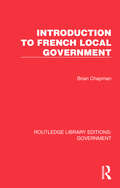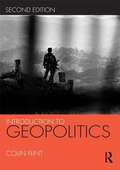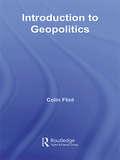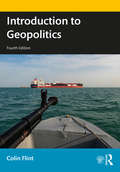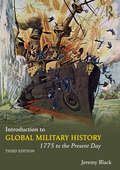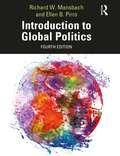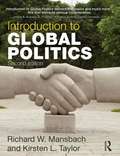- Table View
- List View
Introduction to Comparative Politics: Political Challenges and Changing Agendas
by Mark Kesselman Joel Krieger William A. Joseph"Introduction to Comparative Politics offers accessible material for an introductory comparative politics course. Edited by a highly respected team of scholars, each of the text' s twelve country studies is written by an expert in the field. Four innovative themes, each with a specific focus, form the framework of the text: "The World of States, "Governing the Economy, "The Democratic Idea, and "The Politics of Collective Identities. A classification system focuses on levels of democracy, including established, transitional, and non-democracies. A chapter on the United States follows the same lines of comparison as those on other countries. Every chapter includes four to six sidebars, which focus on different subjects, including leaders, citizen action, institutional intricacies, current challenges, and global connections.
Introduction to Comparative Politics: Political Challenges and Changing Agendas, AP* Edition
by Mark Kesselman Joel Krieger William A. JosephNIMAC-sourced textbook
Introduction to Contemporary Political Theory
by Colin Farrelly`This text provides an up to date account of how things currently stand in political philosophy, and will provide an excellent introduction for students from any background. It gives a lucid and careful account of the central controversies and sites of disagreement in political theory over the last thirty years and rather than sacrifice theoretical sophistication and nuance for the sake of clarity and accessibility, it admirably achieves both′ - Catriona McKinnon, University of York This comprehensive textbook provides a complete and accessible introduction to the main theorists and issues in contemporary political theory today. The text is organized into two major parts. The first, Contemporary Liberal Theory, outlines four distinct liberal theories of justice to introduce the work of Rawls, Nozick, Gauthier and Dworkin. The second, Alternative Traditions, introduces the theorists and themes associated with four key areas of contemporary debate: communitarianism, multiculturalism, deliberative democracy and feminism. By giving students questions for consideration and using applied examples throughout, the text illustrates the practical relevance of contemporary theoretical debates to everyday issues in policy and politics. The result is an essential overview of all the main traditions, issues and positions in political theory today that will serve as an invaluable resource for all students of contemporary political theory, political ideas and political philosophy. Colin Farrelly is Assistant Professor in the Department of Political Science at the University of Waterloo, Canada. Introduction to Contemporary Political Theory will complement Contemporary Political Theory: A Reader edited by Colin Farrelly and also published by SAGE Publications.
Introduction to Crime Analysis: Basic Resources for Criminal Justice Practice
by Deborah Osborne Susan WernickeSuccessfully analyze crime at any level of law enforcement! This book is a practical resource guide for the development of crime analysis in local law enforcement. The tragedy of September 11, 2001, has raised awareness on how crucial it is to analyze information and intelligence. Smaller agencies that cannot financially justify hiring a full-time analyst will find strategies and techniques to teach officers the methods of analysis. Introduction to Crime Analysis: Basic Resources for Criminal Justice Practice provides basic tools and step-by-step directions that will improve the skills and knowledge of new crime analysts. From the editors: "Military strategists have used analysis for centuries; it makes sense to know as much as possible about the enemy and about the conditions and causes of a situation if we hope to institute any kind of significant change for the better. Career criminals are the enemies of a community's well being. Now that advances in information technology give us the means and methods to fully examine and find meaningful knowledge in the vast amounts of existing information on crimes and criminals, we have an obligation to use our technological strength to protect innocent people. Systematic crime analysis as a law enforcement and public safety asset has become not only possible, but also truly necessary as a weapon in the war against crime." Along with defining the various roles of the crime analyst, Introduction to Crime Analysis demonstrates how to: improve the personal skills necessary to make you a good crime analyst successfully work through the five stages-collection, collation, analysis, dissemination, and feedback and evaluation-of analysis select the appropriate crime mapping software for your agency evaluate the usefulness of your crime analysis products benefit from email discussion groups and professional associations create a crime analysis unit-including policies and procedures as well as marketing and funding This clearly written resource includes case studies, figures, and appendixes that will simplify the learning process. Links to Internet pages also offer resources and information beneficial to both new and experienced crime analysts. Introduction to Crime Analysis will benefit crime analysts, police officers, intelligence analysts, community groups focused on crime prevention, criminal justice students, and police departments and sheriff&’s agencies.
Introduction to Critical Theory: Horkheimer to Habermas
by David HeldThe writings of the critical theorists caught the imagination of students and intellectuals in the 1960s and 1970s. They became a key element in the formation and self-understanding of the New Left, and have been the subject of continuing controversy. Partly because of their rise to prominence during the political turmoil of the sixties, and partly because they draw on traditions rarely studied in the Anglo-American world, the works of these authors are often misunderstood.In this book David Held provides a much-needed introduction to, and evaluation of, critical theory. He is concerned mainly with the thought of the Frankfurt school—Horkheimer, Adorno, Marcuse, in particular—and with Habermas, one of Europe's leading contemporary thinkers. Several of the major themes considered are critical theory's relation to Marx's critique of the political economy, Freudian psychoanalysis, aesthetics, and the philosophy of history. There is also a discussion of critical theory's substantive contribution to the analysis of capitalism, culture, the family, and the individual, as well as its contribution to epistemology and methodology.Held's book will be necessary reading for all concerned with understanding and evaluating one of the most influential intellectual movements of our time.
Introduction to Crowd Management: Managing Crowds in the Digital Era: Theory and Practice
by Katsuhiro Nishinari Claudio Feliciani Kenichiro ShimuraThis book will guide you in a simple and illustrative way through all aspects related to crowd behaviour, including sociological theories, methods of crowd control, people detection and tracking, and crowd simulation and prediction, while examining previous accidents to learn from the past. Crowds are a constant presence in most cities around the globe and mass gatherings are attracting an increasing number of people. While experience can help manage large crowds and plan mass events, knowledge on crowd behaviour is fundamental for successfully dealing with unexpected situations, improving current practices and implementing state-of-the-art technologies in management strategies. After letting people laugh about the controversy on colliding pedestrians, with this book, two of the Ig Nobel laureates on pedestrian traffic will make you think (and learn) presenting through a collaborative approach, combining theoretical with practical advice, the science behind crowd dynamics and the importance it plays in our increasingly urbanized society. Fundamental aspects related to crowd management are presented using simple concepts requiring little or no knowledge of mathematics or engineering. Professionals involved in pedestrian traffic, as well as students and researchers entering the field of crowd dynamics, will find this book a useful interdisciplinary introduction on the subject, exploring both fundamental background information and more specific topics related to crowd management.
Introduction to Cyber Politics and Policy
by Mary ManjikianIntroduction to Cyber Politics and Policy is a comprehensive introductory textbook for cyber politics and security courses, and the perfect addition to any International Relations or Intelligence course. Written by Mary Manjikian, an expert in the field and an instructor who has taught the course for ten years, it assumes no prior knowledge of technical concepts, legal concepts, military concepts or international relations theory. Instead, she aims to bridge the gaps between the intricacies of technology and the theories of political science. The book emphasizes the importance of collaboration and understanding between the two fields - students from both technology and political science backgrounds need to understand the implications of technology decisions and the policy questions that arise from them in order to make a meaningful contribution to ever-changing field.
Introduction to Cyber Politics and Policy
by Mary ManjikianIntroduction to Cyber Politics and Policy is a comprehensive introductory textbook for cyber politics and security courses, and the perfect addition to any International Relations or Intelligence course. Written by Mary Manjikian, an expert in the field and an instructor who has taught the course for ten years, it assumes no prior knowledge of technical concepts, legal concepts, military concepts or international relations theory. Instead, she aims to bridge the gaps between the intricacies of technology and the theories of political science. The book emphasizes the importance of collaboration and understanding between the two fields - students from both technology and political science backgrounds need to understand the implications of technology decisions and the policy questions that arise from them in order to make a meaningful contribution to ever-changing field.
Introduction to Digital Humanism: A Textbook
by Hannes Werthner Allison Stanger Carlo Ghezzi Jeff Kramer Bashar Nuseibeh Julian Nida-Rümelin Erich PremThis open access textbook introduces and defines digital humanism from a diverse range of disciplines. Following the 2019 Vienna Manifesto, the book calls for a digital humanism that describes, analyzes, and, most importantly, influences the complex interplay of technology and humankind, for a better society and life, fully respecting universal human rights. The book is organized in three parts: Part I “Background” provides the multidisciplinary background needed to understand digital humanism in its philosophical, cultural, technological, historical, social, and economic dimensions. The goal is to present the necessary knowledge upon which an effective interdisciplinary discourse on digital humanism can be founded. Part II “Digital Humanism – a System’s View” focuses on an in-depth presentation and discussion of the main digital humanism concerns arising in current digital systems. The goal of this part is to make readers aware and sensitive to these issues, including e.g. the control and autonomy of AI systems, privacy and security, and the role of governance. Part III “Critical and Societal Issues of Digital Systems” delves into critical societal issues raised by advances of digital technologies. While the public debate in the past has often focused on them separately, especially when they became visible through sensational events the aim here is to shed light on the entire landscape and show their interconnected relationships. This includes issues such as AI and ethics, fairness and bias, privacy and surveillance, platform power and democracy. This textbook is intended for students, teachers, and policy makers interested in digital humanism. It is designed for stand-alone and for complementary courses in computer science, or curricula in science, engineering, humanities and social sciences. Each chapter includes questions for students and an annotated reading list to dive deeper into the associated chapter material. The book aims to provide readers with as wide an exposure as possible to digital advances and their consequences for humanity. It includes constructive ideas and approaches that seek to ensure that our collective digital future is determined through human agency.
Introduction to Emergency Management
by Gary Webb Brenda Phillips David M. NealEmergency management university programs have experienced dramatic and exponential growth over the last twelve years. This new, fully updated edition introduces majors and minors to the field and provides content accessible to those students taking introductory emergency management courses. The book’s student-centered focus looks at the regional, state, and local level response, as well as some of the often misunderstood or overlooked social aspects of disasters. Real-world cases are described throughout including considerations of international emergency management and disasters alongside features from former students now working as professionals in the field of emergency management.
Introduction to Emergency Management
by Damon P. Coppola Jane A. Bullock George D. HaddowIntroduction to Emergency Management, Eighth Edition sets the standard for excellence in the field and has educated a generation of emergency management professionals. This trusted resource provides a comprehensive overview of core concepts in emergency management and instructs in their application, addressing why the emergency management profession exists, what actions its professionals and practitioners are tasked with performing, and what achievements are sought through the conduct of these various efforts. Students and new professionals alike will gain an enhanced understanding of key terminology and concepts, enabling them to work with emergency management specialists. <P><P>Fully updated throughout, the new edition includes revised workflows and communications; explanations of FEMA, state, and local emergency management organizational policies; the growing role of the private sector in emergency management; Covid-19 pandemic preparedness and response; and the impact of climate change on emergency management policies and practices, among other timely examples and application areas. Each chapter features all-new case studies on recent disasters, key terms, summary points, and self-review questions. <P><P>Student and faculty use is supported by an expanded ancillary package, featuring a fuller instructor manual, lecture PowerPoint Slides, and linked documents, data sets, references, and video examples. - Empowers the next generation of emergency management professionals, applying core disaster management approaches and principles across timely, illustrative case studies - Considers the impact of climate change, among other current global challenges, on emergency management policies and practices - Reviews and instructs in emergency management communication, workflows, and organizational policy best practices - Contains an updated, online instructor manual, lecture PowerPoint Slides, further case studies, video examples, and other supporting materials.
Introduction to Emergency Management and Disaster Science
by Brenda D. Phillips David M. Neal Gary R. WebbA definitive resource, the Introduction to Emergency Management and Disaster Science presents the essentials to better understand and manage disasters. The third edition of this popular text has been revised and updated to provide a substantively enriched and evidence-based guide for students and emerging professionals. The new emphasis on disaster science places it at the forefront of a rapidly evolving field. This third edition offers important updates, including: Newly commissioned insights from former students and professional colleagues involved with emergency management practice and disaster science; international policies, programs, and practices; and socially vulnerable populations. Significantly enriched content and coverage of new disasters and recent research, particularly the worldwide implications of climate change and pandemics. Pedagogical features like chapter objectives, key terms and definitions, discussion points and resources. The only textbook authored by three winners of the Blanchard Award for excellence in emergency management instruction. Online Support Material with instructional videos containing practical information and learning objectives for the next generation of emergency managers and disaster scientists. The Introduction to Emergency Management and Disaster Science is a must-have textbook for graduate and undergraduate students and is also an excellent source of information for researchers and professionals.
Introduction to Energy Analysis
by Kornelis Blok Evert NieuwlaarThe energy supply and demand system is of great importance for society, from economic, social, and ecological viewpoints. The last decade in particular has seen rapid changes in the world of energy systems, and it is therefore now an important area for study, academic research, and professional work. This textbook provides an introduction to energy analysis for those students who want to specialise in this challenging field. In comparison to other textbooks, this book provides a balanced treatment of complete energy systems, covering the demand side, the supply side, and the energy markets that connect these. The emphasis is very much on presenting a range of tools and methodologies that will help students find their way in analysing real world problems in energy systems. Featuring learning objectives, further readings and practical exercises in each chapter, An Introduction to Energy Analysis will be essential reading for upper-level undergraduate and postgraduate students with a background in the natural sciences and egineering. This book may also be useful for professionals dealing with energy issues, as a first introduction into the field.
Introduction to Executive Protection (Third Edition)
by Dale L. June<p>At a time when personal security risks are on the rise internationally, Introduction to Executive Protection, Third Edition takes readers beyond "the wizard’s curtain" of fear, unawareness, and surprise to give them the tools to sharpen or renew their skills so those they are tasked with protecting remain safe. <p>This third edition of a bestseller goes beyond the basics which were at the heart of the first and second editions. Though it still covers those basics, it goes further by exploring and discussing the lessons learned in the history of assassination―from ancient times to the present. <p>Examining the psychological, philosophical, professional, and training aspects of close personal protection, this edition represents the latest thinking on executive protection in light of increased personal security risks worldwide. It discusses both residential and business security and also covers the first response for natural events such as common medical emergencies.</p>
Introduction to Forensic Science: The Science of Criminalistics
by James T. SpencerIntroduction to Forensic Science: The Science of Criminalistics is a textbook that takes a unique and holistic approach to forensic science. This book focuses on exploring the underlying scientific concepts as presented at the introductory college and senior high school levels. Chapters introduce readers to each of the important areas of forensic science, grouping chapters together by discipline and following a logical progression and flow between chapters. This systematically allows students to understand the fundamental scientific concepts, recognize their various applications to the law and investigations, and discern how each topic fits broadly within the context of forensic science.The writing is accessible throughout, maintaining students’ interest – including both science and non-science majors – while inspiring them to learn more about the field. Concepts are demonstrated with numerous case studies and full-color illustrations that serve to emphasize the important ideas and issues related to a particular topic. This approach underscores scientific understanding, allowing the student to go beyond simple rote learning to develop deeper insights into the field, regardless of their scientific background. This book has been extensively classroom-tested to provide the most comprehensive and up-to-date survey of various forensic disciplines and the current state of the science, policies, and best practices. Key features: Presents a wholly new, fresh approach to addressing a broad survey of techniques and evidentiary analyses in the field of forensic science. All concepts – and the underpinnings of forensic practice – are explained in simple terms, using understandable analogies and illustrations to further clarify concepts. Introduces topics that other introductory texts fail to address, including serology, behavioral science, forensic medicine and anthropology, forensic ecology, palynology, zoology, video analysis, AI/computer forensics, and forensic engineering. Highly illustrated with over 1,000 full-color photographs, drawings, and diagrams to further highlight key concepts. Suitable for both high school senior-level instruction and two- and four-year university courses for majors, non-majors, and criminal justice students enrolled in introductory forensic science classes. Support Materials – including an Instructor’s Manual with test bank and chapter PowerPoint lecture slides – are available to professors with qualified course adoption.
Introduction to French Local Government (Routledge Library Editions: Government)
by Brian ChapmanOriginally published in 1953, this was the first post-War study in either English or French of the institutions and law relating to French local government and on the practice of French local administration. It is a study in political science and therefore, although the basic laws governing local institutions are dealt with in some detail, the aim is to give a picture of those institutions at work in the middle of the 20th Century. The book assumes no prior knowledge of the subject and will be of interest to students of French government and comparative political institutions.
Introduction to Geopolitics
by Colin FlintThis clear and concise introductory textbook guides students through their first engagement with geopolitics. It offers a clear framework for understanding contemporary conflicts by showing how geography provides opportunities and limits upon the actions of countries, national groups, and terrorist organizations. This second edition is fundamentally restructured to emphasize geopolitical agency, and non-state actors. The text is fully revised, containing a brand new chapter on environmental geopolitics, which includes discussion of climate change and resource conflicts. The text contains updated case studies, such as the Korean conflict, Israel-Palestine and Chechnya and Kashmir, to emphasize the multi-faceted nature of conflict. These, along with guided exercises, help explain contemporary global power struggles, environmental geopolitics, the global military actions of the United States, the persistence of nationalist conflicts, the changing role of borders, and the new geopolitics of terrorism, and peace movements. Throughout, the readers are introduced to different theoretical perspectives, including feminist contributions, as both the practice and representation of geopolitics are discussed. Introduction to Geopolitics is an ideal introductory text which provides a deeper and critical understanding of current affairs, geopolitical structures and agents. The text is extensively illustrated with diagrams, maps, photographs and end of chapter further reading. Both students and general readers alike will find this book an essential stepping-stone to understanding contemporary conflicts.
Introduction to Geopolitics
by Colin FlintThis clear and concise introduction to the field of geopolitics highlights how geographic factors are important in determining whether tensions become conflicts, and whether or not resolutions are just and long-lasting.
Introduction to Geopolitics
by Colin FlintThis new updated edition of Introduction to Geopolitics presents the overarching themes of geopolitical structures and agents in an engaging and accessible manner, which requires no previous knowledge of theory or current affairs. Using new pertinent case studies and guided exercises the title explains the contemporary global power of the United States and the challenges it is facing, the persistence of nationalist conflicts, migration, cyberwar, terrorism, and environmental geopolitics. Case studies of the rise of the so-called Islamic State, the South China Sea disputes, the Syrian civil war, the Korean conflict, and Israel-Palestine emphasize the multi-faceted nature of conflict. The book raises questions by incorporating international and long term historical perspectives and introduces readers to different theoretical viewpoints, including feminist contributions. The new edition features expanded sections on network geopolitics and non-state actors, a new section on geopolitics of transnational business, cyberwar, an interpretation of ISIS within historical geopolitical trends, as well as expanded discussion of the relevance of Boserup and neo-Malthusians to environmental geopolitics. Introduction to Geopolitics will provide its readers with a set of critical analytical tools for understanding the actions of states as well as non-state actors acting in competition over resources and power. Both students and general readers will find this book an essential stepping-stone to a deeper and critical understanding of contemporary conflicts.
Introduction to Geopolitics
by Colin FlintThis new updated edition presents the overarching themes of geopolitical structures and agents in an engaging and accessible manner, which requires no previous knowledge of theory or current affairs. It helps readers understand the geopolitical implications of COVID-19, China’s pronounced role in the world, the relative decline of the US, and the Black Lives Matter movement. Using new pertinent case studies and guided exercises, the title explains the contemporary global power of the United States and the challenges it is facing, the changing foreign policy of China and other countries, the persistence of nationalist conflicts, migration, cyberwar and cyberactivism, terrorism, energy geopolitics, and environmental geopolitics. Expanded case studies of the South China Sea disputes and China’s Belt and Road Initiative emphasize the multi-faceted nature of conflict. The book raises questions by incorporating international and long-term historical perspectives and introduces readers to different theoretical viewpoints, including feminist contributions. The new edition features fresh discussion of island geopolitics, the Anthropocene age, and geoeconomics. Introduction to Geopolitics will provide its readers with a set of critical analytical tools for understanding the actions of states as well as non-state actors acting in competition over resources and power. Both students and general readers will find this book an essential stepping-stone to a deeper and critical understanding of contemporary conflicts. The companion website will enable readers to apply the themes of the book to the constant shifts in current affairs to enable deeper understanding. It will provide access to weekly essays showing how the themes explain current events.
Introduction to Global Military History: 1775 to the Present Day
by Jeremy BlackThis lucid account of military developments around the modern world begins with the American War of Independence and the French revolutionary wars and continues chronologically to the latest 21st century conflicts. It combines determinedly global coverage with thought-provoking analysis not only of the military aspects of conflict but also its social, cultural, political and economic dimensions and consequences. By placing familiar events alongside the largely unknown, the reader is forced to reassess the standard grand narrative of military history that rests on assumptions of Western cultural and technological superiority. It will be essential reading for students worldwide, whether studying modern military history, modern world history, history and international relations or war and society. This fully updated second edition includes: chapter introductions and conclusions to assist study and revision 'Voices of War' sourced extracts from the field of conflict case studies in each chapter to support the narrative and provoke discussion a 12-page colour map section and over 20 other integrated maps annotated references from the latest publications in the field
Introduction to Global Military History: 1775 to the Present Day
by Jeremy BlackIntroduction to Global Military History provides a lucid and comprehensive account of military developments around the modern world from the eighteenth century up to the present day. Beginning with the background to the American War of Independence and the French Revolutionary wars and ending with the recent conflicts of the twenty-first century, this third edition combines fully up-to-date global coverage with close analysis not only of the military aspects of war but also its social, cultural, political and economic dimensions and repercussions. The new edition includes a fully revised chapter on conflicts during the eighteenth century, updated coverage of events post-1990 and increased coverage of non-Western conflicts to provide a truly international account of the varied and changing nature of modern military history. Covering lesser-known conflicts as well as the familiar wars of history and illustrated throughout with maps, primary source extracts and case studies, it is essential reading for all students of modern military history and international relations.
Introduction to Global Politics
by Richard W. Mansbach Ellen B PirroIntroduction to Global Politics, Fourth Edition, is an accessible, comprehensive, and well-written introductory textbook which emphasizes the evolution of major global issues from the past to the present. By integrating theory and political practice at individual, state, and global levels, students are introduced to key developments in global politics, helping them make sense of major trends that are shaping our world. This completely revised and updated edition includes new material on: •the dramatic shift in US policies under President Donald Trump and the post-Trump moves to redo the global scene •the coronavirus pandemic and its impact around the world •Brexit, and its consequences for the European Union •the rise of China and Russia in the international order •technological developments in weaponry and the militarization of outer space * the growing importance of the politics of identity, the environment, nationalism and populism while retaining much of the structure and many of the features of past editions, including a revised range of faculty and student aids– a test bank, flashcards, glossary, web links, PowerPoint slides, chapter outlines, suggested video clips, map exercises, cultural references, and boxed features. Stimulating and provocative, the book is designed to appeal to students and instructors interested in international relations as a broadly defined, multidisciplinary subject encompassing politics, history, economics, military science, psychology, sociology, anthropology, and philosophy.
Introduction to Global Politics
by Richard W. Mansbach Kirsten L. TaylorFully revised and updated, the second edition of Introduction to Global Politics places an increased emphasis on the themes of continuity and change. It continues to explain global politics using an historical approach, firmly linking history with the events of today. By integrating theory and political practice at individual, state, and global levels, students are introduced to key developments in global politics, helping them make sense of major trends that are shaping our world. This is a highly illustrated textbook with informative and interactive boxed material throughout. Chapter opening timelines contextualise the material that follows, and definitions of key terms are provided in a glossary at the end of the book. Every chapter ends with student activities, cultural materials, and annotated suggestions for further reading that now include websites. Key updates for this edition: New chapter on 'The causes of war and the changing nature of violence in global politics' New chapter on 'Technology and global politics' Enhanced coverage of theory including post-positivist theories Uses 'levels of analysis' framework throughout the text New material on the financial crisis, BRIC and Iran Introduction to Global Politics continues to be essential reading for students of political science, global politics and international relations.
Introduction to Global Politics
by Richard W. Mansbach Kirsten L. TaylorFully revised and updated, the second edition of Introduction to Global Politics places an increased emphasis on the themes of continuity and change. It continues to explain global politics using an historical approach, firmly linking history with the events of today. By integrating theory and political practice at individual, state, and global levels, students are introduced to key developments in global politics, helping them make sense of major trends that are shaping our world. This is a highly illustrated textbook with informative and interactive boxed material throughout. Chapter opening timelines contextualise the material that follows, and definitions of key terms are provided in a glossary at the end of the book. Every chapter ends with student activities, cultural materials, and annotated suggestions for further reading that now include websites. Key updates for this edition: New chapter on 'The causes of war and the changing nature of violence in global politics' New chapter on 'Technology and global politics' Enhanced coverage of theory including post-positivist theories Uses 'levels of analysis' framework throughout the text New material on the financial crisis, BRIC and Iran Introduction to Global Politics continues to be essential reading for students of political science, global politics and international relations.
